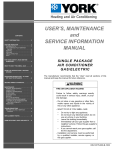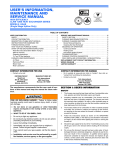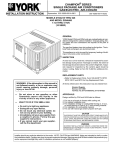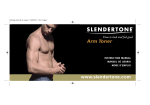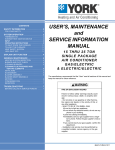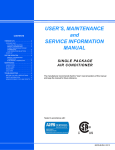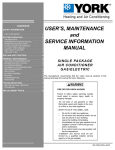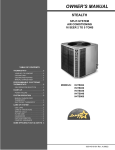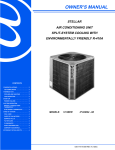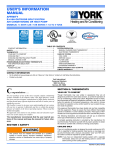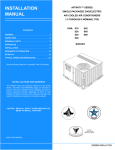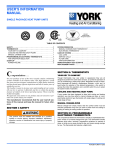Download York Heating & AIR CONDITIONER User's Manual
Transcript
530.46-O1Y (995) 035-13080 ® WARNING: If the information in this manual is not followed exactly, a fire or explosion may result causing property damage, personal injury or loss of life. — Do not store or use gasoline or other flammable vapors and liquids in the vicinity of this or any other appliance. — WHAT TO DO IF YOU SMELL GAS • Do not try to light any appliance. • Extinguish any open flames. • Do not touch any electrical switch; do not use any phone in your building. • Immediately call your gas supplier from a neighbor’s phone. Follow the gas supplier’s instructions. • If you cannot reach your gas supplier, call the fire department. — USER’S INFORMATION MANUAL Installation and service must be performed by a qualified installer, service agency or the gas supplier. SINGLE PACKAGE AIR CONDITIONER GAS/ELECTRIC Congratulations . . . On your purchase of our Single Package Air Conditioning Unit. This energy efficient unit has been precision designed, manufactured of high quality materials and has passed many rigorous inspections and tests to ensure years of satisfactory service. This manual is meant to increase your understanding of your system, tells you how to operate it efficiently and how to obtain the greatest measure of comfort at the lowest operating expense. Please read this manual thoroughly. We appreciate your interest in our products and your decision to purchase our Single Package Unit. Enjoy your comfort. This gas/electric, heating/cooling unit is designed for outdoor use and can be installed anywhere from grade level to the roof. Electric air conditing in the summer and gas heating in the winter - all from a single unit. SYSTEM OPERATION THERMOSTATS Set your thermostat for either heating or cooling then set it for the desired temperature. DO NOT MOVE THE THERMOSTAT RAPIDLY ON AND OFF, OR BACK AND FORTH FROM HEAT TO COOL. THIS COULD DAMAGE YOUR EQUIPMENT. Always allow at least 5 minutes between changes. Find the temperature that is most comfortable to you, and then LEAVE YOUR THERMOSTAT ALONE. (Exception is for night or vacation "set back" to conserve energy) Manually moving the thermostat up or down will not speed up temperature changes in your rooms. This only causes the thermostat switch to function at your command rather than responding to room temperature. Heat generated by devices other than the furnace may interfere with thermostat performance. Therefore, lamps, radios, television sets, etc. should not be placed near the thermostat. HOT SURFACE PILOT IGNITION DEVICE This unit is equipped with a hot surface pilot ignition device. The control is designed to automatically light the burner each time the thermostat "calls" for heat. CAUTION: Do not attempt to manually light the burners. Personal injury could result 2 HEATING When the thermostat calls for "HEAT", the thermostat energizes the combustion air blower. After airflow is established, the air proving switch closes, the hot surface ignitor is energized and the pilot valve opens igniting the pilot flame. The flame rod senses a flame and de-energizes the ignitor opening the main gas valve and the main burners light. 30 seconds after the main burners light the circulating fan is energized at the heating speed. When the thermostat is satisfied, the ignition system is de-energized closing the gas valve. After a 5 second postpurge timing period, the combustion air blower is de-energized and the heat fan off timing begins. When this field selected heat fan off timing is completed the circulating fan is de-energized. If the primary, rollout and auxiliary limit switches open, the thermostat and ignition system is de-energized and the gas valve closes. The combustion blower and the circulating fan, at heat speed, are energized. The combustion blower remains energized for the 5 second postpurge timing period if the primary, rollout and auxiliary limit switches remake the contact (the rollout and auxiliary limit switches must be manually reset). The circulating fan remains energized for the selected heat delay off timing. Normal operation of the system resumes. COOLING When the thermostat calls for "COOL", the thermostat signals the compressor and outdoor fan to run. After a cool fan on delay timing of 2 seconds, the circulating fan is energized at cooling speed. When the thermostat is satisfied, the compressor and outdoor fan is de-energized, After a cool fan off delay timing of 30 seconds the circulating fan is deenergized. CIRCULATING FAN When the thermostat calls for "FAN", the thermostat terminal signals the circulating fan to run at the heat speed 2 seconds after the thermostat is energized. If a call for "HEAT" occurs, the circulating fan continues to run at the heat speed. If a call for "COOL" occurs, the circulating fan switches to cool speed after a 4 second delay. When the thermostat ends the call for "FAN", the thermostat is de-energized, de-energizing the circulating fan. INPUT The correct heat capacity of the furnace is regulated by the burner orifices and the gas pressure. The proper orifices are furnished but the gas pressure regulator must be adjusted by the installing serviceman or gas company. This is a "one-time" adjustment. WARNING: Should overheating occur, shut off the manual gas valve external to the appliance before shutting off the electrical supply. Unitary Products Group FOR YOUR SAFETY, READ BEFORE OPERATING WARNING: If you do not follow these instructions exactly, a fire or explosion may result, causing property damage, personal injury or loss of life. START-UP INSTRUCTIONS HEATING SYSTEM NOTE: See General instructions for Start-up and Shutdown of your gas heating system. 1. STOP! Read the safety information. A. BEFORE OPERATING, smell all around the appliance area for gas. Be sure to smell around the base of the unit because some gas is heavier than air and will settle in the area. WHAT TO DO IF YOU SMELL GAS • Do not try to light any appliance. • Do not touch any electrical switch. • Do not use any phone in your building. • Immediately call your gas supplier from a neighbor’s phone. Follow the gas supplier’s instructions. • If you cannot reach your gas supplier, call the fire department. B. Use only your hand to push in or turn the manual gas knob. Never use tools. If the knob will not push in or turn by hand, don’t try to repair it, call a qualified service technician. Force or attempted repair may result in a fire or explosion. C. Do not use this appliance if any part has been under water. Immediately call a qualified service technician to inspect the appliance and to replace any part of the control system and any gas control which has been under water. Unitary Products Group 2. Set the thermostat to the lowest setting. 3. Make sure all electrical power to the furnace is "OFF". 4. This appliance has a device which automatically lights the pilot and in turn, lights the burners. 5. Remove burner access panel by removing screws and lifting panel out. 6. Turn the manual gas knob to the "OFF" position. 7. Wait five (5) minutes to clear out any gas. If you then smell gas, STOP! Follow step A in the safety information. If you don’t smell gas, go to to next step. SHUTDOWN INSTRUCTION - TO TURN OFF GAS TO APPLIANCE CAUTION: Should overheating occur, or the gas supply fail to shut off, shut off the manual gas valve to the furnace before shutting off the electrical supply. 1. Set the thermostat to the lowest setting. 2. Turn off all electrical power to the appliance if service is to be performed. 3. Remove burner access panel by removing screws and lifting panel out. 4. Turn the manual gas knob to the "OFF" position. MANUAL GAS KNOB SHOWN IN “OFF” POSITION 8. Turn the manual gas knob to the ON position. 9. Replace the control access panel. 10. Turn on all electrical power to the appliance. 5. Replace the control access panel. 11. Set the thermostat to the desired setting. 12. If the appliance will not operate, follow the instruction "To Turn OFF Gas To Application" and call your service technician or gas supplier. 3 PROPER CARE OF YOUR SYSTEM Filters should be checked monthly especially since this unit is used for both heating and cooling. CAUTION: Prior to any of the following maintenance procedures, shut off all power to the unit. REGISTERS Supply air and return air registers must be open when the unit is in operation. Furniture must not block airflow in or out of the registers. LUBRICATION The indoor blower motor, outdoor fan motor and ventor motor are permanently lubricated and require no maintenance. COIL CARE An annual check and cleaning, if necessary, of the condenser coil should be done. Clean any debris and dirt from the outside coil face with a brush being careful not to damage the fins. If extremely dirty, a hose can be used to wash the coil from the inside out while brushing a soapy solution on the outside. GENERAL MAINTENANCE The manufacture recommends that the furnace system be inspected once a year by a qualified service person. For proper and safe operation, the gas heating section needs air for combustion and ventilation. Do not block or obstruct air openings on the unit, nor the spacing around the unit. Keep the gas heating system area clear and free of combustible materials, gasoline and other flammable vapors and liquids. Snow or debris should not be allowed to accumulate in or around the unit. Do not permit overhanging structures or shrubs to obstruct condenser air discharge or vent outlet on your unit. These provide air for combustion and ventilation. FILTER CARE Single phase units are shipped without a filter and is the responsibility of the installer to secure a filter in the return air ductwork or install a Filter/Frame Kit (1FF0110). A filter rack and a high velocity filters are standard on three phase units. Filters must always be used and must be kept clean. When filters become dirt laden, insufficient air will be delivered by the blower, decreasing your units efficiency and increasing operating costs and wear-and-tear on the unit and controls. TROUBLESHOOTING BEFORE CALLING A SERVICEMAN: A. Check thermostat setting and insure thermostat is calling for heat or cooling. B. Check thermostat for lint, dust, etc. C. Check fuses or circuit breakers. D. Check filters for excessive dust accumulation and/or restriction. PARTS INFORMATION UPG renewal parts may be obtained from your local qualified UPG contractor-check the yellow pages in your telephone directory. SOME EFFICIENCY DO’S AND DON’TS DON’T heat or cool unused areas. Reduce supply and return air flow to a minimum in areas which are not living spaces (storage rooms, garaged, basements, etc.). DON’T be a "thermostat jiggler". Moving your thermostat setting will not make your system heat or cool any faster. Adjust your thermostat to a comfortable setting and leave it there. Unitary Products Group P.O. Box 1592, York, Pennsylvania USA 17405-1592 Subject to change without notice. Printed in U.S.A. Copyright by York International Corporation 1995. All Rights Reserved. DON’T restrict air circulation. Placing furniture, rugs, etc. in such a way that they interfere with air vents will make your system work harder to achieve a comfortable temperature level. This requires more energy, which means greater cost to you. DON’T heat or cool when you are away. If you are going to be away for a day or more, re-adjust your thermostat accordingly. Your furniture is far less demanding than you are when it comes to comfort levels. However, don’t expect the system to restore comfort conditions immediately upon returning home. It will take a little time. DON’T locate lamps or other heatproducing appliances (radios, TV’s, heaters, etc.) near your thermostat. The heat from these items will give your thermostat "false information" about the temperature in the room. DO select a comfortable thermostat setting, but keep in mind that moderation in temperature selection will save energy. DO turn on your kitchen exhaust fan when cooking and your bathroom exhaust fan when showering. Also, make sure your clothes dryer is properly vented. If these items are neglected, an excess heat and humidity condition may be created, causing your air conditioning system to run longer. DO set your thermostat a few degrees lower than normal several hours before entertaining a large group of people in a relatively small area. People give off a considerable amount of heat and moisture in a closed area. DO keep drapes and Venetian blinds closed when practical. These items provide insulation against heat loss/gain. DO contact a qualified service man to make repairs or adjustments to your system. He has been trained to perform this service. 530.46-O1Y




